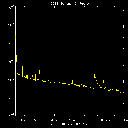

Here we see the GOES soft-channel flux decaying in an interesting manner. The background level (lower envelope) decreases almost linearly, on this semilog plot, for one decade over a time interval of 6 days - an e-folding time of 2.6 days (well, it is a bit of a coincidence that it's "e" days within errors!) maintained over this fairly long time interval. This contrasts strongly with the sharp limb-occultation decrease typically observed for a given isolated active region (for a good example, see Sterling et al., 1997.
What do the Yohkoh images tell us about where this decrease originates? What is getting fainter?

The above shows SXT images for the given times (click on image to see a larger more visible version). One must be a bit careful, since these are shown in the usual "SFD compression" scheme, a logarithm. However the only striking difference is the active region at the NW limb, which is in fact being occulted by rotation. But this cannot be the source of the long-term decay, according to the Sterling et al. result.
So, we must infer that the general corona - perhaps the population of weak active regions, ephemeral regions, and bright points that we see - is in fact coherently decaying across the entire volume of the corona. This is of course just a conjecture right now, but isn't it an interesting likelihood? Are we seeing the "impulse response" decay of the global coronal brightness following a cessation of new magnetic flux injection? If so, what could possibly have this long a time scale? Somebody should look at the behavior of the individual active regions during this time and see if they are guilty of exponential decay.